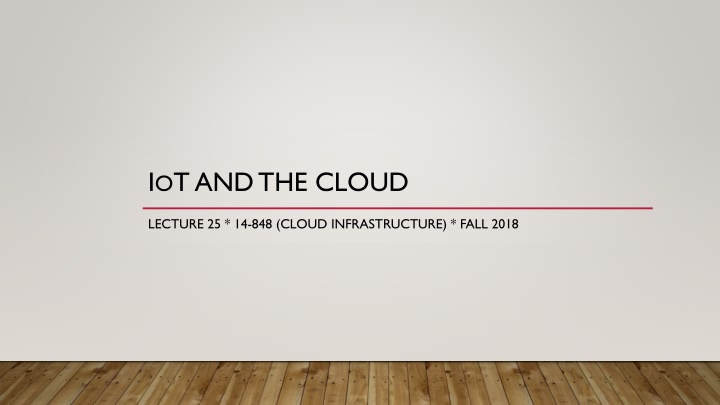
Internet of Things (IoT) and Cloud Infrastructure
Discover the concept of the Internet of Things (IoT) and its connection to cloud infrastructure. Explore how IoT devices interact with the real world, examples of IoT applications, the complexity of IoT devices, connectivity methods, and example protocols like Bluetooth and Zigbee.
Download Presentation

Please find below an Image/Link to download the presentation.
The content on the website is provided AS IS for your information and personal use only. It may not be sold, licensed, or shared on other websites without obtaining consent from the author. If you encounter any issues during the download, it is possible that the publisher has removed the file from their server.
You are allowed to download the files provided on this website for personal or commercial use, subject to the condition that they are used lawfully. All files are the property of their respective owners.
The content on the website is provided AS IS for your information and personal use only. It may not be sold, licensed, or shared on other websites without obtaining consent from the author.
E N D
Presentation Transcript
IOT AND THE CLOUD LECTURE 25 * 14-848 (CLOUD INFRASTRUCTURE) * FALL 2018
INTERNET OF THINGS (IOT) What is the Internet of Things ? Not the Internet of Humans It is the Internet of Devices Or the Internet of Connected Devices , if you like redundancy What does that mean? Different types of hardware (not homogeneous in purpose, environment, or form) Connected (versus stand-alone) Via the Internet (vs locally)
COMMON THEMES OF THINGS Interact with real world Relay data (observations) from real world Manipulate real world
EXAMPLES OF THINGS Thermostats, weather monitors Door locks, garage door openers Fitness/Health monitors Industrial/Vehicle sensors Household and Industrial appliances Security-related sensors
HOW BIG IS A THING? Single sensor Device consisting of multiple sensors Abstraction for a domain augmented with multiple sensors E.g. Modelling a room as a temperature, humidity, CO2level, and light level Each update contains tuple Is a room an average temperature, across exterior, interior, and special use spaces (like shower)? Or is each sensor a separate device? Single average value? Tuple of multiple values to be averaged? Complexity can be managed at device level, and local level, or by cloud. Device abstraction may vary
HOW ARE THEY CONNECTED? To be part of the Internet of things connectivity must ultimately be via the Internet But not necessarily directly Not all connected devices are IoT, because not all connected devices involve the Internet Why not necessarily directly connected? Energy and distance (or combination) are often concerns Cost from complexity might be another Often connected via a Gateway Direct, wired Direct, wireless Mesh networks, Trees, Stars, etc.
EXAMPLE PROTOCOLS Bluetooth You re familiar with this. Paired communication Low-energy variant for IoT Zigbee Low-energy mesh network Device identification, messaging, etc 128-bit encryption
EXAMPLE PROTOCOLS Message Queue Telemetry Transport (MQTT) Brokered Publisher-Subscriber model Based upon hierarchical topics TCP transport MQTT-SN (Sensor Network) Works without TCP, over serial lines, over Zigbee, etc. Topics IDed by numbers, not strings Needs TCP gateway
ROLES OF A GATEWAY Provide connectivity to Internet Provide HTTPS, TLS, or other secure channel Protocol translation from local to IPv4/v6 Aggregating and/or compressing smaller updates Caching updates until connectivity is possible Caching OS/Firmware updates until application is possible
SECURITY CONCERNS Gateway and Gateway-Internet interaction Often relatively easy to secure using common techniques Thing -Gateway Interaction Often times harder to secure Light-weight Security costs too much in complexity, money, and/or power requirements
ROLE OF THE CLOUD What devices? Inventory, coordinate, manage and configure What to do with data? Collect it Analyze it Learn from it Act upon it What to do with devices? Interact with real world Coordinate across devices Cloud-based platforms provide this infrastructure
CLOUD-BASED SERVICES: DEVICE MANAGEMENT Register devices to service Authentication Identify device Authorization Identify its rights Configure devices Maintain updates etc
CLOUD-BASED SERVICES: MANAGING COMMUNICATION Coordinate publishers Coordinate subscribers Buffering communications Intermittent connectivity Limited ability to store data for retries Configuration management messages Commands (to impact real world)
CLOUD-BASED SERVICES: MAINTAINING DATA Store data on behalf of devices Store configuration or identification data and proxy for device Represent device during power saving cycles Offer cached results from most recent data Store data for long-term use
CLOUD-BASED SERVICES: PIPELINE PROCESSING Data processing is often a pipeline Receive data Transform/Normalize it Augment it Combine with other data from other sources Aggregate it, e.g. in database(s), etc. Post process it (ML, AI, analytics, etc) Often times requires a very high-throughput pipeline for initial processing Batch processing can do ML, etc, later
CLOUD AND IOT SUMMARY Back-end for IOT often lives in the cloud Provides for all of the management of the devices Registration, authentication, authorization, configuration Manages communication Publisher-subscriber Cached state, recent values, etc Manages data Filter, normalize, transform, augment, aggregate, store Analyzes data Triggered and batch processing, e.t.c. Often pipelined Coordinates interaction Opens garage, sends alarms/alerts, etc.
